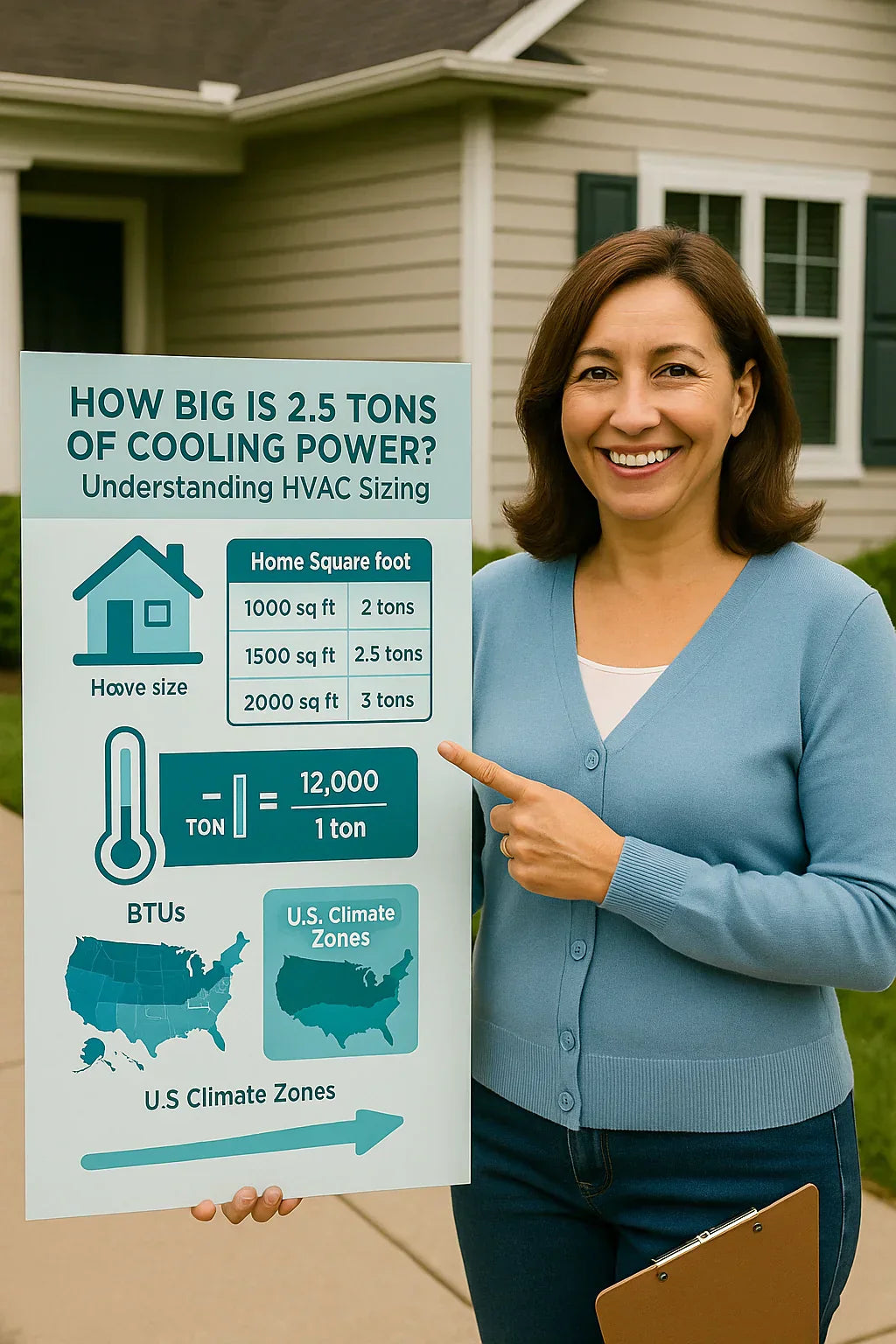When you're evaluating a new HVAC system, one of the most important — and most misunderstood — numbers is the system's tonnage. What does a 2.5-ton air conditioner or gas furnace combo actually mean for your home's comfort, efficiency, and energy costs?
This guide will help you break down the math, myths, and measurements behind HVAC tonnage, so you can confidently decide if a 2.5-ton system is the right fit for your square footage, climate zone, and lifestyle.
❄️ What Does "2.5 Ton" Mean in HVAC?
Despite how it sounds, HVAC tonnage has nothing to do with the system's weight. Instead, it refers to cooling capacity.
-
1 ton = 12,000 BTUs/hour
-
2.5 tons = 30,000 BTUs/hour
That means a 2.5-ton AC can remove 30,000 BTUs of heat from your home every hour. This makes it suitable for mid-sized homes in the 1,200 to 1,600 sq. ft. range, depending on factors like insulation, layout, and location.
🏡 What Size Home Needs a 2.5 Ton System?
HVAC sizing is about more than square footage. The right system size depends on:
-
Climate Zone (hot, humid, or temperate?)
-
Home layout (open concept vs. compartmentalized)
-
Ceiling height
-
Window type and exposure
-
Insulation quality
Here’s a rough estimate by square footage:
| Home Size | Suggested Tonnage |
|---|---|
| 1,000–1,200 sq. ft. | 2.0 tons |
| 1,200–1,600 sq. ft. | 2.5 tons |
| 1,600–2,000 sq. ft. | 3.0 tons |
👉 Use ACCA Manual J to perform a load calculation
🌡️ Climate Zone Considerations
The same 1,500 sq. ft. home in Arizona vs. Vermont will require very different HVAC capacity. Here's why:
-
Hot, dry zones (e.g., Phoenix) may need more cooling capacity
-
Humid areas (e.g., Florida) demand systems that dehumidify effectively
-
Cold zones (e.g., Minnesota) place more emphasis on heating efficiency
Use the DOE's climate zone map to check your region.
👉 Climate Zones – DOE Building America
🧮 The Importance of Manual J Load Calculations
The gold standard for HVAC sizing is the Manual J calculation, which considers:
-
Home orientation
-
Insulation and air sealing
-
Duct layout
-
Local weather patterns
-
Internal heat gain from appliances
Avoid rule-of-thumb calculations. Oversizing or undersizing can cause:
-
Higher utility bills
-
Poor humidity control
-
Uneven temperatures
-
Short cycling and premature wear
👉 HVAC Load Calculator – CoolCalc Manual J
⚖️ What Happens If Your System Is the Wrong Size?
Too Big:
-
Short run times
-
Humidity problems
-
Increased wear and tear
Too Small:
-
Can't keep up in peak heat/cold
-
Constant running
-
Discomfort in larger rooms
Getting the size just right means:
-
Efficient cycling
-
Better comfort
-
Lower energy costs
🛠️ Sizing Tips for Different Home Types
-
Older Homes: Likely less insulated; may require more BTUs than a new home of the same size.
-
Mobile or Modular Homes: Need smaller systems with strong duct sealing.
-
Multi-Story Homes: May need separate systems or zoning.
-
Homes With Large Windows: Account for solar heat gain (especially south/west exposure).
🔧 Matching Furnace and AC Sizes in Combo Systems
If you’re buying a gas furnace and AC combo, like a 2.5-ton R-32 system, make sure:
-
Furnace BTU capacity complements your cooling load
-
Blower motor supports airflow for both heating and cooling
-
SEER2 and AFUE ratings are balanced for year-round savings
✅ Is a 2.5 Ton System Right for You?
You’re likely a good fit for 2.5 tons if:
-
Your home is 1,200–1,600 sq. ft.
-
You're in a temperate or moderate climate
-
Your windows and insulation are in good shape
-
You’ve had a Manual J or professional load calc done
🔍 Final Takeaway: Don’t Guess — Measure
HVAC sizing isn't just a guess based on square footage — it's a science. A 2.5-ton system may be perfect for your home, or it may leave you too hot, too cold, or paying too much.
Get a professional load calculation, work with a licensed contractor, and ask for R-32 systems with smart efficiency features. For most mid-sized homes, this combo delivers the best of comfort, compliance, and long-term value.
👉 Browse R-32 2.5 Ton Systems: The Furnace Outlet
In the next topic we will kow more about: Dual Fuel HVAC Systems Explained: Is R-32 the Right Fit?







